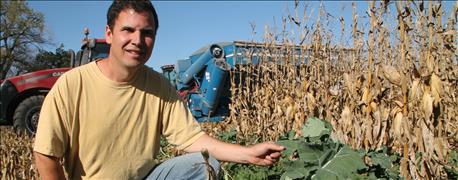April 24, 2016

For the past four years, Chris Nelsen, Mission Hill, S.D., has sown cover crop seed mixes into standing corn.
He says he obtained the best results on dryland acres by flying on the seed in June. On irrigated acres, Nelsen flies seed on after corn plants begin to decline in late August.

Chris Nelsen checks the growth on a cover crop at harvest time last year. He interseeded the cover crop in June into standing corn.
“What I’ve found is that by the time I plant the cover crop in late June, there’s no competition issue with corn for space or nutrients,” Nelsen says. “There’s also no problem with herbicide carryover. When we fly it on, a small amount of the cover crop seed catches in the corn plant whorls, but it’s not a problem. The biggest challenges to getting the cover crop established are adequate moisture and getting enough sunlight through the corn canopy.”
To check whether cover crops weren’t taking moisture or nutrients away from his corn crop, Nelsen compared yield from two 200-acre fields, one planted with cover crops and one without. He was pleased to find no difference between the two in either yield or plant quality.
All of Nelsen’s cover crop plants die out with freezing temperatures and he plants directly into residue in spring. He won’t rule out using his cover crops for grazing, but has no current plan to do so.
His cover crops haven’t successfully emerged and matured every year, but he believes the long term benefits of the practice outweigh input cost of between $35 and $40 per acre.
“I believe part of what’s happening with the cover crops in standing corn is a symbiosis that occurs in a plant polyculture,” Nelsen says. “From what I’ve seen so far, the benefit of planting cover crops into standing corn is providing long term benefits that are well worth the investment.��”
He says the organic matter in fields has risen from an about 2.5-2.7% to 4-4.5%. He’s also seen improved water infiltration and all but eliminated soil erosion.
“The soil organic matter increase has probably been my most dramatic result,” Nelsen says. “Bringing soil organic matter from 2.5% to 3.0% typically takes quite a while so I’ve been pleased to see my soil samples reflect this improvement.”
What he plants
Nelsen seeds a 15 pound per acre mix of 30% ryegrass, 20% crimson clover, 20% radish, 20% turnip and 10% dwarf essex rape into standing corn.
Justin Fruechte, Millborn Seeds, Brookings, S.D., recommended it.
“The mix provides quick ground cover and late season growth,” Fruechte says. “the High Fly mix is a perfect cocktail for the biodiversity farmers like Chris are looking for. The combination of brassicas, legumes and grasses is also an effective soil erosion shield.”
Sowing cover crops into corn cut for silage also offers a valuable grazing option.
“Cover crops benefit highly erodible ground by stabilizing soil. They also scavenge any leached nutrients in light sandy soil, bringing it back into the plant root zone,” Fruechte says.
Annual rye is a popular cover crop species because it winter kills, eliminating the need for herbicide burn down. Radish taproots are favored since they scavenge nutrients and also alleviate compaction.
“Hi Fly is a common mix for standing corn,” Fruechte says. “But we do customize mixes for farmers who have specific goals they want to accomplish.”
Sorensen is a Yankton, S.D., writer.
You May Also Like




